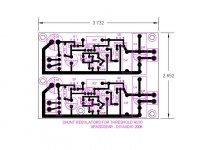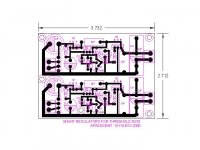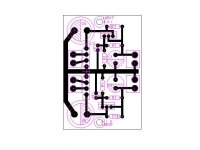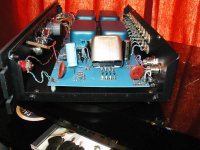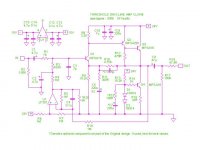Lumanauw, what version of the 2SK30 are you using? If you wrote about it allready, I have forgotten😉
Steen🙂
Steen🙂
lumanauw said:
I want to write about my own (myself) experience. Something that I do not understand until now, is that why many "good" things in textbook do not result in the sonics that I wanted?
For example, there was time that I build cct's with very good regulators, cap multiplier etc. The sound is just "dead". Now I only use 1 R and 1 Cap forming pi-filter, and to me (myself) it sounds better than using complicated rail filter with many semiconductors. Again here I don't know why it is so to my ears. Using passive components (R-L-C) seems to sounds better to me than using semiconductors for rail filter (again : not for anyone's else's ear 😀)
I make many cct's that will be blamed "wrong" from technical POV. I have books like DougSelf's kind of technical book, have built cct's based on those book's tutorial, but now I just make cct's based on 2 pages of Keith Jarret's Foreword in "Complete Guide to High End Audio" by Robert Harley. It helps me to convince myself when I'm making a "technically-wrong" audio cct's 😀
lumanauw said:Question : what do you read in those 2 pages?
There are no "THD" or "S/N ratio" or "Damping factor" word in it. But for me it gives a clue what the "average ears" are looking for. ("average ears" here = everyone who don't design audio amplifiers or have soldering iron in their hands). If the music is sad, you have to be sad hearing the reproduction. If the music is happy, it has to make you happy hearing the reproduction. It's difficult to approach this, and strangely, this characteristic very often can be achieved with cct or approach that is said "wrong" in technical textbooks.
Lumanauw,
That’s a very interesting experience and point of view.
My previous experience dictated that I should have some sort of regulation on line amps, have done most sorts of PSU including L-C but for power amps and have never test these on preamps. Should give it a try, both of them R-C and L-C plus the previously proposed Shunt, I’m sure this will be a very enlighting experience.
Thanks for the input and those scannings from Keith Jarret. 😎
do not forget what I said before ,when I propose shunt reg for NS10 variation...I'm not pretending that I discover any novelty-in fact pretty like reinventing the wheel,but I do not use series reg anymore,at least for line level and similar stages.........
decent R and C (and God forbid -L) based filtration stages are always better to my ears than most sofisticated series regs.... but-decent shunt reg (even with series reg as prereg) is even better than just filtration.....
I dare to use just one gas stabilizing tube ( toob zenner) ditto on plate (anode ) of first toob in phono preamp-without hiss and hum.....same story with SS .....shunt reg is like A class amp,series reg is like AB class....
I know that there is mucho generalizations,but-in few short sentences ,this is my experience till now.....
decent R and C (and God forbid -L) based filtration stages are always better to my ears than most sofisticated series regs.... but-decent shunt reg (even with series reg as prereg) is even better than just filtration.....
I dare to use just one gas stabilizing tube ( toob zenner) ditto on plate (anode ) of first toob in phono preamp-without hiss and hum.....same story with SS .....shunt reg is like A class amp,series reg is like AB class....
I know that there is mucho generalizations,but-in few short sentences ,this is my experience till now.....
Yes Choky, I do remember your comments. And we do have a quest to find the best reg for this stage. So we should test whatever with deem adequate.
I’m determinate to squeeze the best from the NS10 and think it will also be a good mate for the Babelfish. The idea of a high performance BJT linestage is really appealing, be it with JFET input or not. 😉 😎
I’m determinate to squeeze the best from the NS10 and think it will also be a good mate for the Babelfish. The idea of a high performance BJT linestage is really appealing, be it with JFET input or not. 😉 😎
apassgear said:Yes Choky, I do remember your comments. And we do have a quest to find the best reg for this stage. So we should test whatever with deem adequate.
I’m determinate to squeeze the best from the NS10 and think it will also be a good mate for the Babelfish. The idea of a high performance BJT linestage is really appealing, be it with JFET input or not. 😉 😎
yup
I'm not preaching

do not take me too seriously...
where is fun then 😉
Hi, Steenoe
I've tried 2SK30Y and 2SK30GR. I feel that Y is better. Mlooyd1 could be right, the lower Idss is better in this "wrong" application of Jfet 😀
I've tried 2SK30Y and 2SK30GR. I feel that Y is better. Mlooyd1 could be right, the lower Idss is better in this "wrong" application of Jfet 😀
Now we have a PSU layout which is somewhat flexible so some fine tuning can be done.
I have done a double shunt reg for someone wanting one reg per channel or just use one reg for both channels. Even a double mono is possible adding another trafo if you decide to go full bore.
The whole reg is capable of up to 1 Amp regarding parts rating but for this application I don’t see more than some 200 ma even if only one reg is used for both channels.
I have added C5 at the front which is the first smoothing cap before the reg, this part was not shown on the schematic. I think a single 2,200u will do.
R2 has three alternative foot prints. I guess this resistor will be dissipating around 1W for this application so we could use a 3W part, one of those blue things we have come accustom too.
On the output we also have some alternatives regarding caps, a single 1uf film or a 220uf lytic that could also be bypassed with a small film cap, something like 0.22uf.
I have selected a diode bridge, compact and easy to work with, the foot print is for RS105, nothing fancy to it though.
Regarding the PSU for the opamp I will do a LM317/337 affair which could mount on the same main PSU board.
🙂
I have done a double shunt reg for someone wanting one reg per channel or just use one reg for both channels. Even a double mono is possible adding another trafo if you decide to go full bore.
The whole reg is capable of up to 1 Amp regarding parts rating but for this application I don’t see more than some 200 ma even if only one reg is used for both channels.
I have added C5 at the front which is the first smoothing cap before the reg, this part was not shown on the schematic. I think a single 2,200u will do.
R2 has three alternative foot prints. I guess this resistor will be dissipating around 1W for this application so we could use a 3W part, one of those blue things we have come accustom too.
On the output we also have some alternatives regarding caps, a single 1uf film or a 220uf lytic that could also be bypassed with a small film cap, something like 0.22uf.
I have selected a diode bridge, compact and easy to work with, the foot print is for RS105, nothing fancy to it though.
Regarding the PSU for the opamp I will do a LM317/337 affair which could mount on the same main PSU board.
🙂
Attachments
Threshold NS 10
In case anyone is interested I have a NS 10 that was recently updated by Jon Soderberg of Vintage Amp Repair.😀
However upon delivery back to me FedEx Ground did handle the package properly and was damaged.
The on/off switch was broken off and the transformer was dislodged from its mounting prongs.
So if anyone here has a need for one of these let me know. It is repairable, cicuit board not harmed.
At 63 now I am no longer in the diy game.
Anyone interested kindly e mail me with any info you may need and additional pics.
My best to all🙂
In case anyone is interested I have a NS 10 that was recently updated by Jon Soderberg of Vintage Amp Repair.😀
However upon delivery back to me FedEx Ground did handle the package properly and was damaged.

The on/off switch was broken off and the transformer was dislodged from its mounting prongs.

So if anyone here has a need for one of these let me know. It is repairable, cicuit board not harmed.
At 63 now I am no longer in the diy game.
Anyone interested kindly e mail me with any info you may need and additional pics.
My best to all🙂
Attachments
Re: Threshold NS 10
sorry to hear that;
to bad that I'm too far.....
yeoldestereo said:In case anyone is interested I have a NS 10 that was recently updated by Jon Soderberg of Vintage Amp Repair.😀
However upon delivery back to me FedEx Ground did handle the package properly and was damaged.
The on/off switch was broken off and the transformer was dislodged from its mounting prongs.
So if anyone here has a need for one of these let me know. It is repairable, cicuit board not harmed.
At 63 now I am no longer in the diy game.
Anyone interested kindly e mail me with any info you may need and additional pics.
My best to all🙂
sorry to hear that;
to bad that I'm too far.....
All of these shippers of late are just getting brutal in the way they handle packages, then when something happens, they won't pay the claim.
However this is the first I have received from FedEx Ground in this condition.
However this is the first I have received from FedEx Ground in this condition.
Yeoldestereo.
Sorry for that damage. it's a pitty.
Did I undertood correctly that you will be selling the unit as is?
If so let me know🙂
Sorry for that damage. it's a pitty.
Did I undertood correctly that you will be selling the unit as is?
If so let me know🙂
Yes will be sold as is. It is repairable for the duy guys or for parts.
Will be accepting offers and best offer gets it.
Ned
Will be accepting offers and best offer gets it.
Ned
I found what I believe is really the original NS10 schematics, thanks to my brother-in-law, who had a folder with quite a lot of stuff!
If versions of the NS10 exists I do not know. Nelson probably will know!
I think this is basically identical to the one I posted some time ago, but that schematics was probably something I hand copied from this one now attached!
Rolv-Karsten
If versions of the NS10 exists I do not know. Nelson probably will know!
I think this is basically identical to the one I posted some time ago, but that schematics was probably something I hand copied from this one now attached!
Rolv-Karsten
apassgear said:I decided to open yet another NS10 thread, this one is about building a lineamp as close as possible to the original thing with some update ideas.
This has been possible thanks to R-K (Rolv Karsten) who posted a schematic he kept for 27 years that appeared to be faithful to the original in words of Nelson Pass, besides that there were many other valuable contributions such as close up pictures of the naked boards (sans cans) of the line and RIAA PCB’s by Malotron and others. Thanks to all you great guys again.
http://www.diyaudio.com/forums/showthread.php?s=&threadid=67915&perpage=10&pagenumber=49
The idea behind this layout might not be for everyone since I took some “non audiophile” route regarding input and output caps which are not MKP’s but had my reason to it. Laying film caps on the board crated an awful appearance and did not look neat and ended with a big PCB for each channel. So I decided to keep the original spirit and go with lytics and thought that today’s caps are way better than 25 or 30 years ago, so why not?... use some BG or Panasonic FC’s which are way better than the old ones and in some cases being preferred to film caps by some DIY’s. The only big film cap is at the rail decoupling.
Since I wanted short traces and a compact layout I also decided to use the smaller ½ W resistors with an over all length of 0.360” (9.15mm) so no Dales RD-55’s, though I know in some places on the layout it is possible to add longer lead resistor and could add some pads, but for the time being only short resistors are possible.
All 3 signal BJT are as close as possible and the overall signal path is as short as it gets with these type and size of components which was one of the premises I started with, so I expect that the overall performance of this layout be quite good.
The overall size of the PCB is 3.110 X 2.125” (79 X 54 mm) one sided and uses no jumpers so its easy to etch and build. Most of the traces are 0.035” (0.89 mm) smaller pads are 0.080” (2mm) really don’t know how difficult could be to etch this by oneself with the regular photocopy transfer process. Any ideas?
Related to the bias opamp I decided it should have double rails for best stability and this enable to use any type with standard pinout you may have at hand, rails then should be 18/15 +-V. It’s a single unit DIP so one on each channel as the Master did.
I will welcome all suggestions so please chip in to make this layout better.
Attachments
Re: Re: Threshold NS10 Lineamp PCB
R-K
Wow, thanks again, excellent contribution, Rolv. We now have both line and RIAA stages.
As you say, I guess the previous schematic (RIAA one) was drawn from this one taking in consideration the notes appearing on this schematic. So I would venture to say that both are correct.
So now we are headed to the real thing having all the values correct!!!!
😎 😎 😎





R-K Rønningstad said:I found what I believe is really the original NS10 schematics, thanks to my brother-in-law, who had a folder with quite a lot of stuff!
If versions of the NS10 exists I do not know. Nelson probably will know!
I think this is basically identical to the one I posted some time ago, but that schematics was probably something I hand copied from this one now attached!
Rolv-Karsten
R-K
Wow, thanks again, excellent contribution, Rolv. We now have both line and RIAA stages.
As you say, I guess the previous schematic (RIAA one) was drawn from this one taking in consideration the notes appearing on this schematic. So I would venture to say that both are correct.
So now we are headed to the real thing having all the values correct!!!!
😎 😎 😎





For clarity I have redrawn the schematic which is a guide also for the PCB with numbered components.
I have also marked components with a “*” that are not part of the original design. These values, if used, should be tested for best performance.
I have also marked components with a “*” that are not part of the original design. These values, if used, should be tested for best performance.
Attachments
Re: Re: Re: Threshold NS10 Lineamp PCB
😀 My original hand copied drawing consists of two pages: RIAA and line stage. I am pretty sure I made this copies from the recently posted original. Due to no Xerox machine at the time. 🙂
apassgear said:
R-K
Wow, thanks again, excellent contribution, Rolv. We now have both line and RIAA stages.
As you say, I guess the previous schematic (RIAA one) was drawn from this one taking in consideration the notes appearing on this schematic. So I would venture to say that both are correct.
So now we are headed to the real thing having all the values correct!!!!
😎 😎 😎





😀 My original hand copied drawing consists of two pages: RIAA and line stage. I am pretty sure I made this copies from the recently posted original. Due to no Xerox machine at the time. 🙂
apassgear said:For clarity I have redrawn the schematic which is a guide also for the PCB with numbered components.
I have also marked components with a “*” that are not part of the original design. These values, if used, should be tested for best performance.
+/- 15 V for the opamp? I think the original's opamp runs off 0 and +24V. Or?
RK
- Status
- Not open for further replies.
- Home
- Amplifiers
- Pass Labs
- Threshold NS10 Lineamp PCB
